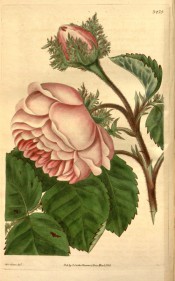Rosa ‘Cristata’
Moss rose. The flowers are rose pink, paler at the edges, often assuming a lilac tint, large and full, globular in shape and beautifully crested. The leaves are also sometimes crested.
Horticultural & Botanical History
It was first noticed growing on the walls of a convent at Friberg, near Berne, in Switzerland in 1820 and introduced to general cultivation by Vibert in 1826. ‘This variety of the Moss Rose, like many of the more novel sorts, was obtained from France. Independantly of the curious mode in which the moss springs in tufts from the edges of its calyx, giving to the early buds a most remarkable appearance, this Rose, when fully expanded, is large, and of the loveliest hue, vying in beauty with any Provins Rose. [BM t.3475/1835].
Rivers says of the ‘Crested Provence’: ‘No rose can be more singular and beautiful: the buds before expansion are so clasped by its fringed sepals that they present a most unique and elegant appearance totally unlike any other rose.’ The ‘Crested Rose’ was illustrated in Willmot as Rosa centifolia var. cristata Prévost. [Gore, Paul (1848, 1863, 1888, 1903), Rivers (1854, 1857, 1863), Willmot, Amat].
History at Camden Park
‘Cristata’ did not appear in any catalogue, but is included in several lists of roses sold from Camden Park in this period and surviving in the Macarthur Papers held at the Mitchell Library. It was described as ‘Moss Crested’ in a list sent to P. P. King. Obtained from Veitch’s Nursery in the same importation as ‘Narcisse’. Not new to the colony but Macarthur considered it rare. [ML A1980-3].
Notes
Published Feb 11, 2010 - 09:28 PM | Last updated Jul 28, 2011 - 05:16 PM
| Family | Rosaceae |
|---|---|
| Category | |
| Region of origin | Garden origin, Switzerland |
| Synonyms |
|
| Common Name | |
| Name in the Camden Park Record |
Rosa Cristata
|
| Confidence level | high |
